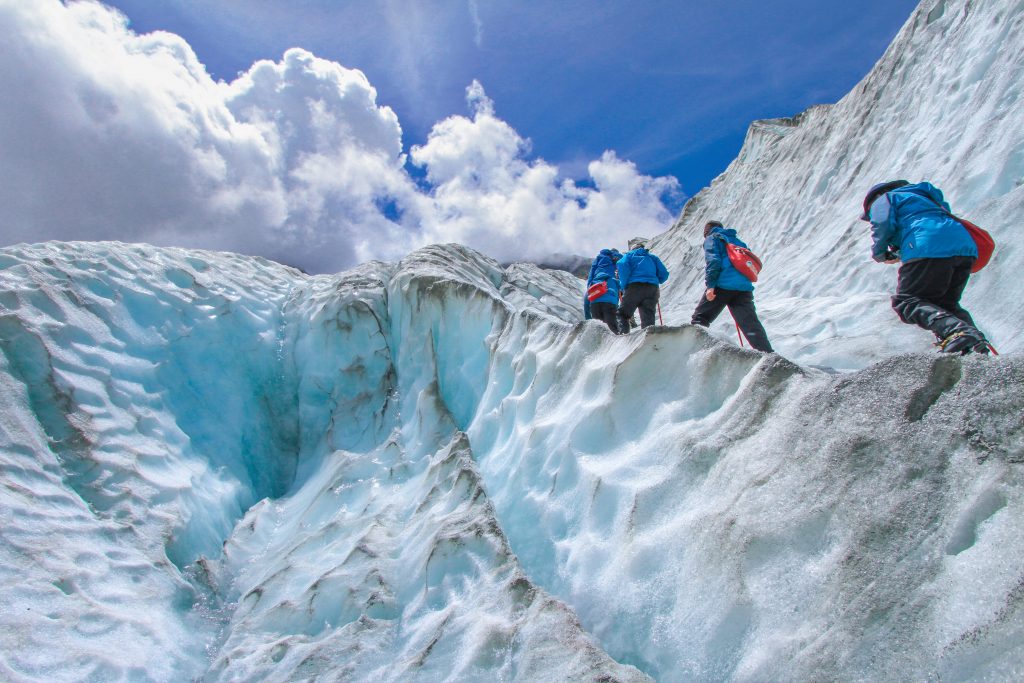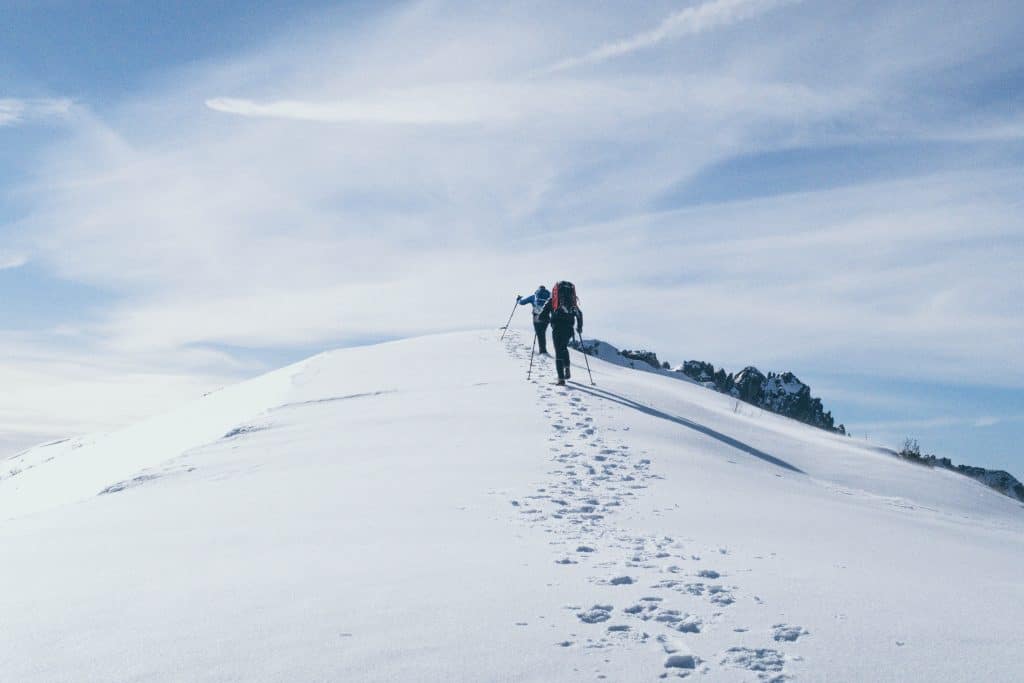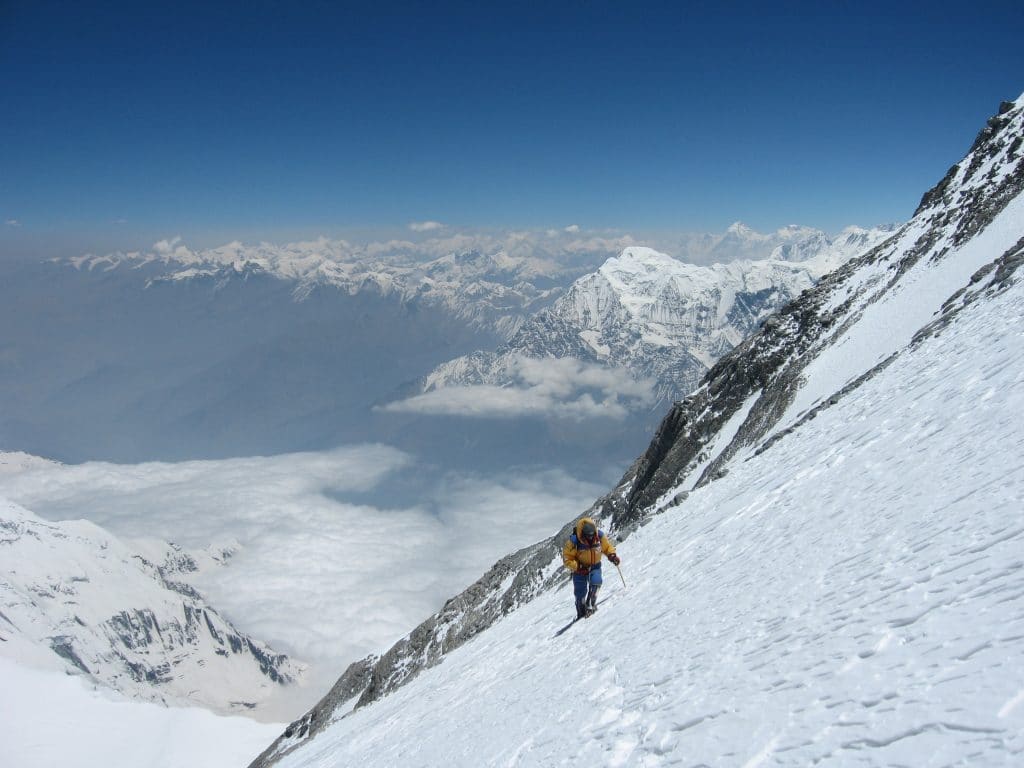Table of Contents
Lots of people on Reddit and climbing forums ask how to get started with mountaineering. I’ve been asked it several times too. There is a ton of info about mountaineering online and offline, but most of it is very specific and detailed. While the focus on one topic is good, I think it’s time for a general guide. I’ll explain when do learn what, what to learn first and what to be careful with. This is all information coming from my personal outdoor and climbing experiences and that of my friends and people i know. I’m no pro, but i do know some coaches and guides and picked their brain for a while now.
How to begin mountaineering? Follow these step-by-step tips to begin mountaineering
- Become a backpacker, do multi day hikes.
- Try winter camping.
- Learn how to rock climb.
- Learn scrambling.
- Go trekking in foreign countries.
- Take a mountaineering class.
- Buy mountaineering gear: Crampons, double boots, etc.
Mountaineering takes time and effort to learn, and this guide should put you on the right track with easy to follow steps. Take it slow! Trying to become a pro while not even knowing the basics is super naive, and especially in the area of mountain skills can be super dangerous too. So take it slow and start small.
We’re going to cover the necessary skills, some advice on picking the right course if you want to join a class (and by the way, I highly suggest you to), and tips for finding right mountaineering partners.
The Basics: What is Mountaineering?
Mountaineering is very exposed hiking off marked routes in challenging alpine territory. There are three main areas of skills involved you need to learn to get started with mountaineering.
Mountaineering consists of alpine climbing, hiking and orientation, and general outdoor backpacking skills.
And it can take place on snow, rock ice or glacial ground. We’re going to have a closer look at the individual skills now!
Learn These Essential Skills To Start Mountaineering
If you wonder how to get started with mountaineering, you should to acquire at least necessary skills in these disciplines.
General outdoor skills: Orientation, emergency planning, and map reading
This is your essential skillset. No matter if afternoon hike or expedition, if you wonder how to get started with mountaineering, this is your basepoint. You need to be able to orientate in mountainous terrain and find your way with compass and map. You’ll also need to develop a mindset of emergency planning as much of mountaineering is focused on safety. Always keep a backup plan, and never panic. Learn these skills by packing your boots and roam the woods and hills around your home area, preferably leaving the marked trails and exploring on your own – but make sure you start in an area where you have a safety net, aka a Park surrounded by roads or railways. You don’t want to wander off in rural Alaska and disappear unless you’re already proficient at orientation.
Hiking and backpacking
Mountaineering comes down to dangerous hiking on big mountains with weird and challenging terrain. So get used to dragging a heavy backpack with gear on hills for hours. This way, your body’s ability to withstand discomfort and pain is increased, and you become used to the idea of doing this for days on end.
You’ll also want to practice building tents, shelter and things like outdoor cooking, fireplace building, etc. As you will need to master them at high altitudes, it’s worth your while to practice in easy mode.
Go camping in the winter
Start backpacking and hiking in summer, but then evolve into winter camping. Start with easy nights out, sleeping by your car. This way, you have a safety net, if you start your feet freezing, you can always rely on the warmth of your vehicle to avoid a disaster. If you feel comfortable enough, go and hike for 30 minutes in an area with cell phone coverage, then spend a night in the snow. This way, you can still return back to civilization if things go terribly wrong, 30 minutes are always doable, and you have the safety of your cellphone in case of emergency. DO NOT go out and remote in winter if you haven’t done this safe style of winter camping at least a couple of times.
Learn to climb, belay and rappel
Learn climbing, read my article about climbing training and my guide for climbing preparation. A mountaineer needs climbing skills, so you need to practice them. Start Toprope and indoor, work your way to outdoor lead climbing and traditional climbing. Read our guide for different styles of climbing. You should also practice belaying and rappelling on some smaller rocks first until you become proficient.
Scramble, climb and do via Ferrata
Once you are comfortable with hiking, you want to start scrambling. Hiking a marked path on steep routes and tackle summits is useful to build up endurance and power, but finding your own way over steep ledges and rock fields is super important. It will teach you to read maps and plan your approach. Route finding is crucial for mountaineers, and you need to be able to do it while tired, exhausted, soaking wet, and cold.
When mountaineering most of the terrain is technically challenging and exposed. So you need to develop a head for heights and get used to climbing via ferratas. Get some experience with hiking class 3 and 4 terrain. If you don’t know about the british terrain grading system, class 3 and 4 is the hardest level of terrain that can still be approached without wearing a harness and safety belay. Read more about it here.
Work on endurance and strength
Go running regularly, and hit the gym. You don’t need to be a powerlifter, but you need to have the heart, lung, and muscular strength to carry a pack through steep terrain in high altitudes for long hours. And running and strength training will give you the needed power and endurance to keep doing it for hours on end.
Train and hike in caloric deficit
Get used to the sensation of low blood sugar and hunger. While planning a mountaineering tour should not involve purposely going on a caloric deficit, weather changes, accidents, and emergency can quickly put you in a position where you need to be able to keep calm and going even when running on fumes. Developing a feeling for this and resilience is something you can and should try in a controlled environment. You can be an excellent trail runner, but it’s a different story to scramble down a ridge on foot if you’re on low blood sugar and shivering from cold rain while wearing a 50 lbs backpack and have been hiking for 6 hours already.
These experiences you should acquire before you start specific mountaineering training
These things you should master first and collect knowledge:
– Hike for longer than 10 hours with a pack in one day
– Experience blisters and pain during hikes
– The feeling of becoming lost, including rising panic
– Become cold and wet during a storm or rainfall and continue walking
– Become cold in winter, and/or soaked in freezing rain
– Be in the mountains and experience how fast weather can change, witness a thunderstorm in the mountains from a safe point (Thunderstorms can be extremely dangerous above treelines)
– Do more than one via Ferrata and climb and scramble steep terrain with the potential of accidents
– Go on a backpacking trip longer than 3 days for three times
– Learn to belay and rappelling
– Be confident in lead climbing french grade 4/5 sport climbing routes in bad weather, know basic knots
Once you have the experience – take a course
There are tons of videos on YouTube about this topic, but a video goes only so far. You need to try these skills out in a guided environment. It’s best to find a course over a week, as it teaches you efficiently and gives enough time to practice and build confidence. There is a lot that could go wrong when mountaineering, and learning from a pro goes a long way. Don’t even worry about gear yet. Do a course first, then decide which equipment to buy. Best courses usually end with a guided tour at the end to try out the newly acquired skills in the wild.
What a Good Mountaineering Beginners Class Should Teach You
A good course should cover the following skills to prepare you for mountaineering. If you take or book a course, make sure to check the contents of the package you buy, and compare it to the list. If you can find tick off most of these points, that’s a good sign. Keep in mind to only book courses from accredited professionals!
Safety and protection techniques for snow and ice
- How to use an ice ax
- Using and setting up crampons
- Self-arresting
- Building anchors in snow and Ice
- Safe traverse of glaciers including crevasse reading and glacial terrain
- Spotting hazards and dangers on a glacier
- Planning a route through a glaciers
- Crevasse rescue
- Ice climbing in alpine terrain
- Multi-pitch climbing
Planning and orientation
- Navigation in the mountains
- Finding effective routes
- Intro to tools like GPS Navigation systems, compass, barometer
- Using topographical maps, triangulations and getting bearings from a map
- Following a course and bearing while roped up
- Finding a bearing without plans and map
Accident and emergency response
- How to evacuate when emergencies happen
- How to travel safely on rocky alpine terrain
- Short-roping basics
- Protection against rocks
- Building anchors on rocks and natural features
- Rappelling in alpine terrain

Beginners Gear For Starting Mountaineering
If you’re serious about mountaineering, you will need gear for both winter camping and of course rock climbing. Get these very basics first, before you buy more sophisticated gear:
Harness for mountaineering
You can use any rock climbing harness for mountaineering, but it needs to have enough room and size, so it even fits when you’re wearing insulating winter pants and jacket. It should also be comfortable, as you’re going to wear it for possibly hours on end
If you want a good all-round harness under 60$, I use a Petzl Corax, and it works really well on rock climbing, via Ferrata and mountaineering. Plus it’s really comfortable.
Crampons
You definitely will need crampons at one point. 12 point semi-rigid ones will work well, and as they have enough flexibility, they will work well on all-mountain types. This is important as glacier walks are different from ice climbing.
Mountaineering boots
A typical modern mountaineering boot has a hard plastic outer body and a soft inner boot. It might seem overkill and too technical, but once you have wet or damp feet, you need the inner boot to be removable to dry and warm it up in your sleeping bag while at basecamp or biwaque.
Ice ax
A lifesaver. These aggressive and curved ice tools are not only used when ice climbing, but also for all sorts of tasks when mountaineering. The standard ice ax is the piolet shape. Its length ranges from 60 to 100cm. And you can use to get stable on steeply sloped approaches and even to arrest yourself when sliding or falling. Plus you can use it to punch steps into snow and ice or even as a makeshift pivot when you drill it into ice.
How To Find A Good Partner For Mountaineering When You Just Get Started
Everything is better together. In the case of mountaineering (and climbing for that matter), this is especially true. A partner in the mountains can be your safety net, and there have been many stories of people who had their partner rescue their lives in case of accidents. Climbing alone where you belay yourself is also an advanced skill you shouldn’t even think about as a beginner.
Where To Search For Mountaineering Partners
But how to find a right and reliable mountaineering partner? Mountaineering is not only climbing, you don’t just spend 2 hours on the crag together, but probably days on days, in cold and terrible weather if you go for multi-day tours.
The first option is to join a club. There are tons of clubs, in North America alone you have the American Alpine Club and Alpine Club of Canada as well as the Sierra Club.
Google is your friend, so type in your region or area and mountaineering or climbing club, and you will find some results. After you finished a course, you can then join a trip organized by the club and see if you find friendly people there.
You could also team up with a friend a do a course together. However, it’s a better idea to partner up with a person more experienced than you if possible – that way, you can learn and get better.
Be a Good Team Member To Find a Mountaineering Partner
By the way, if you join a club and go on a trip with them don’t be an a**. Be respectful, bring good vibes, and help to keep them in the group. Prepare well and show that you’re motivated by taking action and responsibilities over like doing tasks when setting up camp etc.
It’s all about being a constructive member of a team here. After all, if you should end up in a situation where your lives depend on each other, it’s good to know someone will have your back.
What a Mountaineering Partner Should Bring to The Table
You joined a club, maybe even went on a couple of trips with them. And you made some friends, but now you’re planning your first trip alone, and you need to decide who to bring as a partner. Of course, a partner should be someone you feel comfortable spending days out in the wild with, so the very basic human interaction should feel natural, which means you probably need to be on the same wavelength. It’s also no harm to pick someone you feel comfortable having a more extended discussion than 3 sentences with – although this is optional if you’re more the silent type yourself.
But there are some other things you should keep in mind, after all, you’re not just planning a camping trip. Mountaineering can leave you to end up in a situation where your life depends on your partner. So make sure this person is
a) Someone with sufficient attention to detail.
Drilling ice screws, building anchors, etc. is stuff you don’t want to mess up. Sloppy work here means you die in the worst case.
b) Understands safety measures and redundancy.
I’ve personally met many climbers who were not aware of the implications of their actions. Leaving out redundancy measures when it comes to arresting, belaying and anchor building can be fatal. And the point of redundancy is not to be used all the time but rather to be a backup. If someone argues with you about a redundant measure with the argument “never happened to me, I don’t see the point” this is a surefire sign of him not understanding this concept. Ditch him as a partner!

c) Takes responsibility for his actions.
If you screw up, you accept the blame. It’s that easy. There is neither room nor time to argument about these things when you’re on a mountaineering trip. A good partner understands it.
d) Is a problem solver.
The last thing you need on difficult approaches is someone starting arguments about simple stuff. Your partner should be someone who solves problems instead of creating new ones.
e) Keeps a level head.
Yes, there are situations where panic is usual, but try to find someone who is calm and quiet. You can assess this by observing how a person reacts when belaying others, build anchors, arrest himself, etc. Is he calm and focused? Or does he fumble around, gets nervous, etc. Being tense and hectic can also mean he is inexperienced, in this case, you should also think twice about bringing him along – unless you feel confident enough to take a beginner. Beginners should not bring other beginners!
Conclusion
I covered the most important steps on how to get started with mountaineering in this article. We had a look at the different skills needed, now it’s time to go out and practice. Read my guide for climbing preparation, building up climbing endurance, what to keep in mind and why to wear helmets and feel free to comment! Would love to get feedback as always.
Pic source: Either mine or unsplash.

